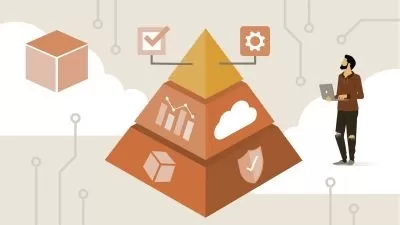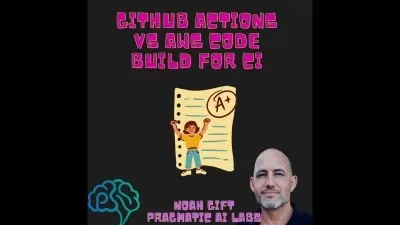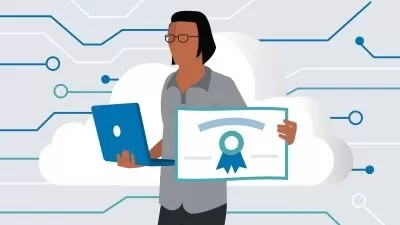Amazon Web Services in Action, Third Edition, Video Edition
Focused View
13:12:41
27 View
001. Part 1. Getting started.mp4
02:08
002. Chapter 1. What is Amazon Web Services.mp4
05:52
003. Chapter 1. What can you do with AWS.mp4
08:35
004. Chapter 1. How you can benefit from using AWS.mp4
07:33
005. Chapter 1. How much does it cost.mp4
04:52
006. Chapter 1. Comparing alternatives.mp4
02:27
007. Chapter 1. Exploring AWS services.mp4
05:12
008. Chapter 1. Interacting with AWS.mp4
04:34
009. Chapter 1. Creating an AWS account.mp4
06:39
010. Chapter 1. Creating a budget alert to keep track of your AWS bill.mp4
03:23
011. Chapter 1. Summary.mp4
01:34
012. Chapter 2. A simple example WordPress in 15 minutes.mp4
11:29
013. Chapter 2. Exploring your infrastructure.mp4
06:41
014. Chapter 2. How much does it cost.mp4
02:45
015. Chapter 2. Deleting your infrastructure.mp4
01:33
016. Chapter 2. Summary.mp4
00:52
017. Part 2. Building virtual infrastructure consisting of computers and networking.mp4
01:53
018. Chapter 3. Using virtual machines EC2.mp4
23:08
019. Chapter 3. Monitoring and debugging a virtual machine.mp4
04:00
020. Chapter 3. Shutting down a virtual machine.mp4
03:16
021. Chapter 3. Changing the size of a virtual machine.mp4
04:45
022. Chapter 3. Starting a virtual machine in another data center.mp4
04:49
023. Chapter 3. Allocating a public IP address.mp4
03:48
024. Chapter 3. Adding an additional network interface to a virtual machine.mp4
07:18
025. Chapter 3. Optimizing costs for virtual machines.mp4
12:33
026. Chapter 3. Summary.mp4
01:18
027. Chapter 4. Programming your infrastructure The command line, SDKs, and CloudFormation.mp4
07:20
028. Chapter 4. Using the command-line interface.mp4
12:15
029. Chapter 4. Programming with the SDK.mp4
08:56
030. Chapter 4. Infrastructure as Code.mp4
04:09
031. Chapter 4. Using AWS CloudFormation to start a virtual machine.mp4
15:41
032. Chapter 4. Summary.mp4
00:58
033. Chapter 5. Securing your system IAM, security groups, and VPC.mp4
05:36
034. Chapter 5. Keeping the operating system up-to-date.mp4
05:26
035. Chapter 5. Securing your AWS account.mp4
16:24
036. Chapter 5. Controlling network traffic to and from your virtual machine.mp4
13:50
037. Chapter 5. Creating a private network in the cloud Amazon Virtual Private Cloud (VPC).mp4
15:01
038. Chapter 5. Summary.mp4
01:39
039. Chapter 6. Automating operational tasks with Lambda.mp4
09:05
040. Chapter 6. Building a website health check with AWS Lambda.mp4
17:01
041. Chapter 6. Adding a tag containing the owner of an EC2 instance automatically.mp4
13:18
042. Chapter 6. What else can you do with AWS Lambda.mp4
11:41
043. Chapter 6. Summary.mp4
01:19
044. Part 3. Storing data in the cloud.mp4
03:15
045. Chapter 7. Storing your objects S3.mp4
03:10
046. Chapter 7. Amazon S3.mp4
02:27
047. Chapter 7. Backing up your data on S3 with AWS CLI.mp4
06:11
048. Chapter 7. Archiving objects to optimize costs.mp4
05:23
049. Chapter 7. Storing objects programmatically.mp4
07:29
050. Chapter 7. Using S3 for static web hosting.mp4
07:56
051. Chapter 7. Protecting data from unauthorized access.mp4
01:40
052. Chapter 7. Optimizing performance.mp4
01:43
053. Chapter 7. Summary.mp4
01:15
054. Chapter 8. Storing data on hard drives EBS and instance store.mp4
19:09
055. Chapter 8. Instance store Temporary block-level storage.mp4
05:52
056. Chapter 8. Summary.mp4
01:27
057. Chapter 9. Sharing data volumes between machines EFS.mp4
09:10
058. Chapter 9. Creating a mount target.mp4
02:32
059. Chapter 9. Mounting the EFS filesystem on EC2 instances.mp4
04:46
060. Chapter 9. Sharing files between EC2 instances.mp4
01:57
061. Chapter 9. Tweaking performance.mp4
11:19
062. Chapter 9. Backing up your data.mp4
04:17
063. Chapter 9. Summary.mp4
01:13
064. Chapter 10. Using a relational database service RDS.mp4
11:27
065. Chapter 10. Importing data into a database.mp4
05:47
066. Chapter 10. Backing up and restoring your database.mp4
10:42
067. Chapter 10. Controlling access to a database.mp4
05:47
068. Chapter 10. Building on a highly available database.mp4
05:21
069. Chapter 10. Tweaking database performance.mp4
09:04
070. Chapter 10. Monitoring a database.mp4
01:42
071. Chapter 10. Summary.mp4
01:22
072. Chapter 11. Caching data in memory Amazon ElastiCache and MemoryDB.mp4
17:44
073. Chapter 11. Cache deployment options.mp4
10:51
074. Chapter 11. Controlling cache access.mp4
04:28
075. Chapter 11. Installing the sample application Discourse with CloudFormation.mp4
08:08
076. Chapter 11. Monitoring a cache.mp4
07:03
077. Chapter 11. Tweaking cache performance.mp4
06:15
078. Chapter 11. Summary.mp4
01:11
079. Chapter 12. Programming for the NoSQL database service DynamoDB.mp4
08:26
080. Chapter 12. Creating tables.mp4
06:23
081. Chapter 12. Adding data.mp4
04:01
082. Chapter 12. Retrieving data.mp4
13:29
083. Chapter 12. Removing data.mp4
01:19
084. Chapter 12. Modifying data.mp4
01:12
085. Chapter 12. Recap primary key.mp4
02:17
086. Chapter 12. SQL-like queries with PartiQL.mp4
02:10
087. Chapter 12. DynamoDB Local.mp4
01:13
088. Chapter 12. Operating DynamoDB.mp4
02:09
089. Chapter 12. Scaling capacity and pricing.mp4
06:35
090. Chapter 12. Networking.mp4
00:54
091. Chapter 12. Comparing DynamoDB to RDS.mp4
01:17
092. Chapter 12. NoSQL alternatives.mp4
00:39
093. Chapter 12. Summary.mp4
01:22
094. Part 4. Architecting on AWS.mp4
02:58
095. Chapter 13. Achieving high availability Availability zones, autoscaling, and CloudWatch.mp4
18:20
096. Chapter 13. Recovering from a data center outage with an Auto Scaling group.mp4
24:45
097. Chapter 13. Architecting for high availability.mp4
05:11
098. Chapter 13. Summary.mp4
01:08
099. Chapter 14. Decoupling your infrastructure Elastic Load Balancing and Simple Queue Service.mp4
13:31
100. Chapter 14. Asynchronous decoupling with message queues.mp4
19:14
101. Chapter 14. Summary.mp4
00:55
102. Chapter 15. Automating deployment CodeDeploy, CloudFormation, and Packer.mp4
13:48
103. Chapter 15. Rolling update with AWS CloudFormation and user data.mp4
06:11
104. Chapter 15. Deploying customized AMIs created by Packer.mp4
07:44
105. Chapter 15. Comparing approaches.mp4
01:19
106. Chapter 15. Summary.mp4
00:55
107. Chapter 16. Designing for fault tolerance.mp4
14:42
108. Chapter 16. Considerations for making your code fault tolerant.mp4
07:33
109. Chapter 16. Building a fault-tolerant web application Imagery.mp4
25:04
110. Chapter 16. Summary.mp4
00:53
111. Chapter 17. Scaling up and down Autoscaling and CloudWatch.mp4
11:24
112. Chapter 17. Using metrics or schedules to trigger scaling.mp4
08:36
113. Chapter 17. Decoupling your dynamic EC2 instance pool.mp4
18:00
114. Chapter 17. Summary.mp4
00:50
115. Chapter 18. Building modern architectures for the cloud ECS, Fargate, and App Runner.mp4
05:30
116. Chapter 18. Comparing different options to run containers on AWS.mp4
05:15
117. Chapter 18. The ECS basics Cluster, service, task, and task definition.mp4
02:48
118. Chapter 18. AWS Fargate Running containers without managing a cluster of virtual machines.mp4
03:53
119. Chapter 18. Walking through a cloud-native architecture ECS, Fargate, and S3.mp4
06:04
120. Chapter 18. Summary.mp4
01:05
More details
User Reviews
Rating
average 0
Focused display
Category

O'Reilly
View courses O'ReillyO'Reilly Media is an American learning company established by Tim O'Reilly that publishes books, produces tech conferences, and provides an online learning platform. Its distinctive brand features a woodcut of an animal on many of its book covers.
- language english
- Training sessions 120
- duration 13:12:41
- Release Date 2023/09/26















